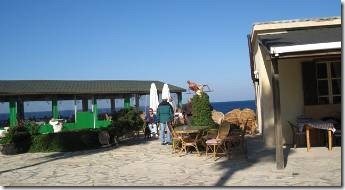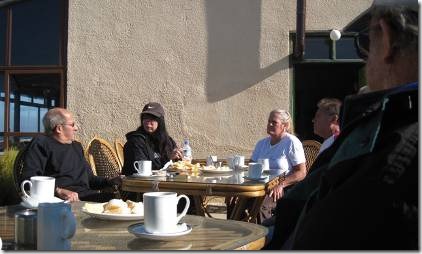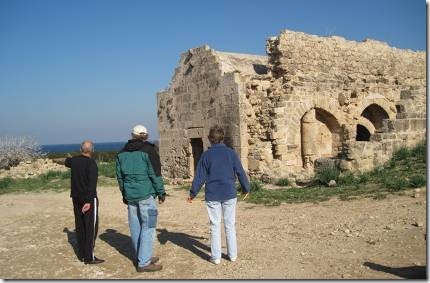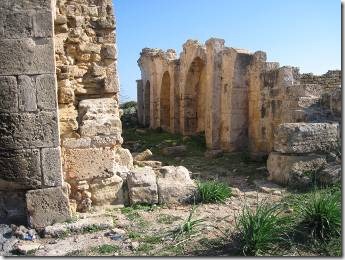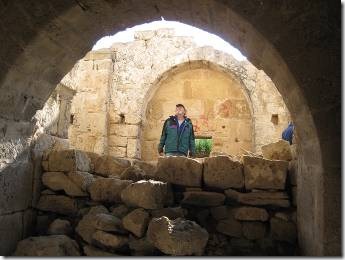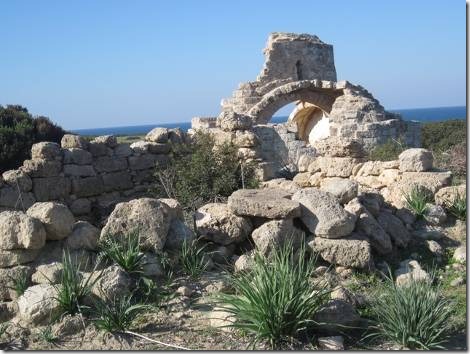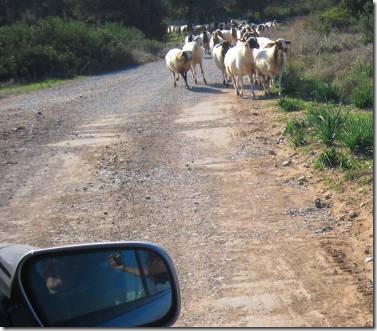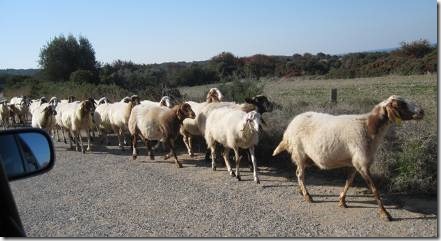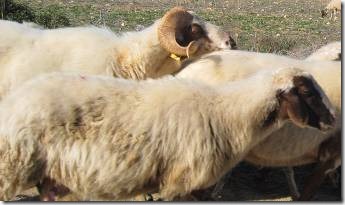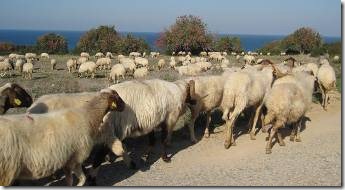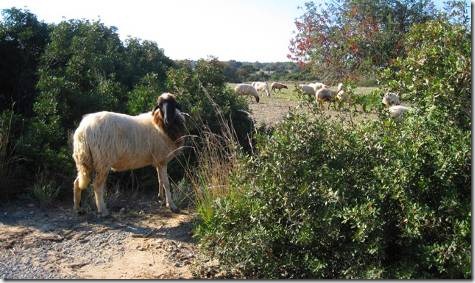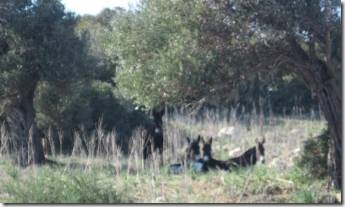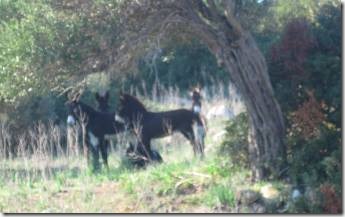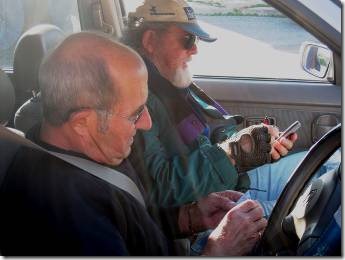Hi Everyone and Happy Holidays whatever you celebrate. Here in North Cyprus the Brits and other Europeans celebrate Christmas, the North Cypriots celebrate Bayram, and everyone celebrates New Years. There is a Jewish community in south Cyprus so they will be celebrating Hanukkah. And just in time for all of that the marina wifi is being terrible making it difficult to email family back home. We do have a dongal, so if the marina wifi won’t work I should be able to email using our Turkcell dongal.
Ru
Our new friends Robin and Julia have included us on several adventures in the past week. We visited Famagusta Monday and Girne yesterday. Today we all did the Deks Thursday walk. Tomorrow we’re riding with them to the small town where they will board Scruffy while they spend Christmas and New Years at a Famagusta hotel. Robin knows a place where they serve the same wonderful grilled sardines like I had in Izmir. In about an hour Randal and I are off to a cruisers holiday party just across and down the dock from us. Surrey Rose is providing all the food and drink. After our uphill walk this morning, to some wonderful views! Randal and I can indulge a bit this afternoon.
This email is the completion of the one I started what seems ages ago about our coast walk to Oasis and Philon Church.
Oasis at Philon and Aphendrika
Time for a coffee at Oasis, a restaurant and beach resort.
Robin, Denise (in black,) Sue, John and Randal
Denise had been orange picking the day before and brought some for us to share with our coffee.
After the coffee, Denise, Michael and his dog Didi got into the van driven by Sue’s partner John and they headed back to Deks. But Robin and Julia offered to continue down the track to the ruins of Aphendrika so we piled into the car and off we went. Julia and I sat in the back seat with her dog Scruffy and I got my pet fix for the week.
Aphendrika
http://www.whatson-northcyprus.com/interest/dipkarpaz/aphendrika.htm
“In the second century BC, Aphendrika was one of the six most important cities in Cyprus…… Like a lot of sites in North Cyprus, much has still to be excavated, and virtually all that remains are the three churches you can see on your approach. To your left is Agios Georgios. Beyond there is Panagia Chrysiotissa, while over to your right you will see Panagia Asomatos.
Panagia Chrysiotissa
Agios Georgios is a late Byzantine church, having been built at the tail end of the 10th century.
It was single aisled with a double apse at the eastern end and niches on either side. West of the apse, you can see the remains of four piers which had arches joining them. These in turn supported a dome on top of a rounded drum, most of which has collapsed. Most of the western end of the church has long gone.
Agios Asomatos Basilica
Close to Agios Georgios is the church of Panagia Chrysiotissa, being built some four hundred years earlier than its neighbour, in the 6th century. After Arab raids, its original wooden roof was replaced by barrel vaulting in the 10th century. Further destruction meant another rebuild in the 16th century. This time the church was much smaller, but enough remains of the ruins for you to get a feel for the size and design of the original.
Over to the right is the church of Panagia Asomatos, loosely translated as "Blessed Virgin Mary, the Devine". It is similar in design to the original Panagia Chrysiotissa, and is the best preserved of the three churches. This was also built in the 6th century as a three aisled basilica. Like its neighbour, it had a wooden roof, again replaced with barrel vaulting in the 10th century. On its southern side, the apsidal passages and barrel vaulting remain.”
Panagia Chrysiotissa
Robin Randal and Julia
Agios Georgios
We got back into the car and headed down the track back to Deks only to be stopped by flocks of sheep coming our way.
One last look!
It’s the strangest sight to see these flocks of sheep just walking down the road seemingly unattended by shepherd or sheepdog (I have been assured that there was a shepherd, I just didn’t see him.) They don’t have the curly wool one thinks of for sheep, but what looks like long hair. Researching North Cyprus sheep is pretty interesting. First I found mention of the ancient and feral Mouflon sheep, but the pictures didn’t look like the sheep we see. Then I found a great article about Awassi sheep and it led me to another article which mentioned the Cyprus fat tailed Chios and again the Awassi sheep. The pictures of the Awassi look like what we see.
The main breeds involved were the Cyprus fat-tailed, Chios and Awassi.
http://www.fao.org/docrep/010/p8550e/P8550E01.htm
Wool.
The Awassi has long wool with an open, lofty and moderately lustrous fleece of carpet wool with distinct, wide crimps. The fleece consists of an outer coat, an undercoat and kemp. It has the principal requisites of carpet wool, namely coarseness and resilience, qualities that make carpet wool resistant to matting down and to wear under the constant scuffing of passing feet. An ideal carpet wool should have a fibre diameter of 30 μ, a fibre length of 10 cm with a 20 percent variation in length, and 4 percent by weight of kempy fibres. Awassi wool complies with these requirements as regards fibre thickness and length, but the fibre length has a greater variation and kemp contents are somewhat greater.
http://www.fao.org/docrep/011/aj003e/AJ003E04.htm
The Cyprus fat-tailed sheep (see appendix Figs A-l and A-2) present a special problem with regard to their relation to the Awassi group. They are undoubtedly allied to the Awassi of the mainland, which they resemble in many physical and physiological respects. Maule (1937) writes that the ‘Palestinian breed… is probably the one nearly akin to the Cyprus sheep’, while Mason (1967), grouping the Cyprus with the Awassi, notes that the Cyprus breed ‘is similar to the breeds of the neighbouring mainland and resembles the Awassi of Syria more than the White Karaman of Turkey’. Yet there are also significant differences between the two breeds, which may be due to the long isolation of the Cyprus sheep on their island or the influence of Turkish sheep. Thus, unlike the head of the Awassi with its typical brown coloration, that of the Cyprus sheep is commonly white with black on the nose and around the eyes, more rarely white, black, brown or mottled. The greatest difference is the size, weight and shape of the fat tail. In the Cyprus the tail is much longer, broader and heavier than in the Awassi, its twisted end often reaching to the ground. It is widest in the middle third and then tapers gradually to the tip, making a half-turn to the right or left at the junction of the middle and lower thirds (Mason, 1967). Mason (personal communication, 1979) also notes that ‘it would be confusing to include the Cyprus as a variety of the Awassi since the name Awassi has never been used for them’.
The Awassi sheep with special reference to the improved dairy type
By H. Epstein
FOOD AND AGRICULTURE ORGANIZATION OF THE UNITED NATIONS
Rome, 1985
ps..I don’t know if these really are Awassi sheep…I’m just guessing.
And then there are the wild donkeys…
http://akti.org.cy/portal/index.php?option=com_content&task=view&id=73&Itemid=47
During the war in Cyprus in 1974, large numbers of domestic donkeys and pigs were allowed to go feral. Most of these were subsequently captured, but feral populations of donkeys and pigs have persisted in the north of the island (e.g., the Karpaz Peninsula). Population estimates are uncertain, and the local Department of environment Protection estimates the number of feral donkeys to be about 300. However, villagers complaining of agricultural damage estimate the population to be in the thousands. Besides these free-ranging populations, the government has been releasing additional donkeys captured and obtained in other parts of the region, in a fenced area on the Karpaz Peninsula. This has raised concerns about the impact of donkeys on native vegetation and wildlife. Although a 22-km2 area of the Karpaz Peninsula was declared to be set aside for conservation purposes, neither organized leadership nor plan was ever set up for the area. Most of this area has been fenced to keep donkeys inside. However, this was not very successful as demonstrated by donkey population found outside of the fenced area. It is not known if there is movement of donkeys across the fence or those outside represent animals that have simply not been captured.
Therefore, the primary goal of this research, undertaken by KAYAD, was to develop abundance estimation techniques and obtain reliable baseline estimates of these populations. (KAYAD is an environmental organization on Cyprus.)
They are definitely cute! But I’m sure they have an environmental impact. We couldn’t get very close and I didn’t want to chase them away trying to get closer. I want one!
We arrived back at Deks about 1 PM. Julia and Robin only wanted a coffee but Randal and I had our usual meze lunch of cheese, yogurt, olives, bread, hummus etc.
Robin looks at our DoraMac boat card while Randal adds Robin’s phone number to his phone. We made plans for a trip to Famagusta the next day. Rob had to go to the dentist (who is Denise’s niece by marriage) and Randal and I were going to find a new computer printer…as ours gave up the ghost while we were in the US.
Julia and Robin are really nice people who are teaching us about North Cyprus and taking us along when they have to go off to Famagusta or Girne or wherever.

